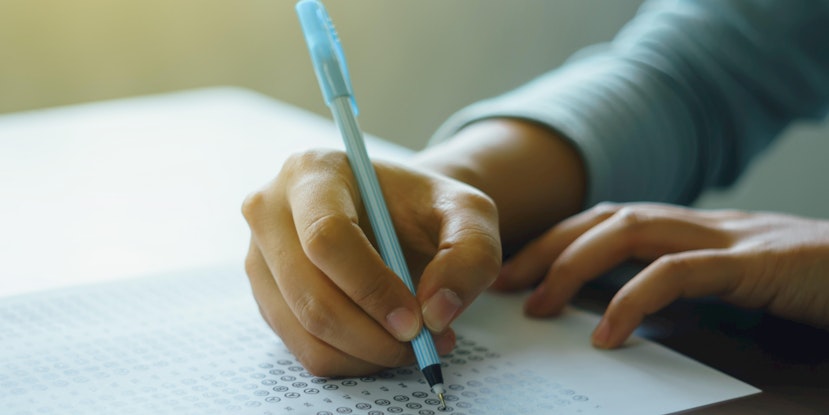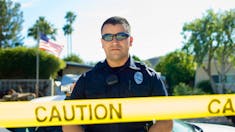CBP Officer Entrance Examination: Practice Tests & Guide 2025
Updated November 20, 2023
- What Is the CBP Officer Entrance Examination?
- What Are the Requirements to Sit the CBP Entrance Exam?
- CBP Entrance Exam - Logical Reasoning Test
empty
- CBP Entrance Exam - Arithmetic Reasoning Test
empty
- CBP Entrance Exam - Writing Skills Test
empty
- How Is the CBP Entrance Exam Assessed?
- CBP Entrance Exam Study Guide (2025)
- Frequently Asked Questions
- Final Thoughts
Customs and Border Protection (CBP) is one of the world’s biggest law enforcement organizations, aiming to keep terrorists and their weapons out of the US while also ensuring lawful travel and trade goes smoothly.
If you want to become a CBP officer there are many steps you need to take.
First, you must check that you fulfill the many basic requirements (like being a US citizen under the age of 40). Then, you will need to make a full application.
Once this has been received and reviewed, you may be invited take your CBP Officer entrance exam at a local test center.
Alongside the CBP entrance exam, you will undergo:
- A qualifications review
- A background check
- A medical exam
- Fitness and drugs tests
- A detailed interview
- A polygraph exam
What Is the CBP Officer Entrance Examination?
The CBP Officer entrance exam is the first step in a candidate’s journey when they apply for a career as a Border Patrol Agent or a Customs and Border Protection Officer.
The test is used by the Federal Government to assess potential recruits on their skills and mental capability to succeed in the CBP Field Operations Academy and serve as an agent.
The CBP Officer entrance exam consists of two parts.
- Virtual assessment
- Officer entrance exam
The virtual assessment (Online Candidate Experience Record) is taken at home. This takes about an hour.
This questionnaire aims to examine your skills and potential, so the questions are usually about past work experiences, qualifications and achievements, as well as your personality.
Second is the actual Officer entrance exam. This is taken on a computer at a test center, supervised by a proctor.
You are required to be there at least 15 minutes early with the right documentation and ID to check-in.
The test can last for up to four hours, including short breaks.
The exam is divided into three sections, with a set amount of time for each:
- Logical reasoning – 81 minutes
- Arithmetic reasoning – 87 minutes
- Writing skills – 47 minutes
There is a five-minute tutorial section at the beginning, showing you how to use the system.
There is also a five-minute break between the logical reasoning and arithmetic reasoning sections, and a 10 minute break before the writing skills section.
This means the CBP Border Patrol entrance examination takes around four hours.
You are allowed to use both a calculator and pen-and-paper during the exam. However, you cannot bring your own, so you are given these items on site.
You can bring in bottled water, but all other personal items have to be left in your car or the storage area provided.
All psychometric tests have their own rules. You cannot skip back to previous questions or on to the next question without entering an answer. Therefore, try your hardest to work out the correct answer.
However, with the CBP Border Patrol entrance exam, there is no penalty for guessing answers. So, if you are stuck on a question, enter your best guess and move on, instead of wasting more time.
What Are the Requirements to Sit the CBP Entrance Exam?
If you are applying for a CBP Officer role, in order to take the exam, you will be expected to have – or be willing to learn – Spanish.
This is assessed in two ways:
- A language proficiency test
- The Artificial Language Test
The language proficiency test will be given if you are already fluent in Spanish. It is divided into a vocabulary and a grammar section.
If you are not currently fluent in Spanish, there is the possibility to take an ‘Artificial Language Test’ (ALT).
This assesses whether you have the aptitude to pick up Spanish easily.
This test has questions based on an artificial language (with a list of associated vocabulary and grammatical rules) to determine whether you would be able to learn Spanish quickly.
Other requirements include:
- Be under the age of 40
- Be a US citizen
- Have a valid driver’s license
- Have been resident in the US for three out of the past five years
- Be eligible to carry a fireman
Additionally, you cannot have taken the CBP entrance exam in the last six months.
Practice CBP Test with JobTestPrep
CBP Entrance Exam - Logical Reasoning Test
The logical reasoning part of the CBP Officer entrance exam requires you to show careful attention and focus by making sound decisions based on the information provided in the exam.
It is multiple-choice – the questions include a passage to read and then statements or questions with five response choices to pick from.
You must draw a valid conclusion from the information given or decide that the given statement cannot be fairly concluded.
All the information you need will be provided in the reading given. You are not expected to know or rely on any information from outside, beyond common knowledge, as the CBP are not aiming to test what you know but instead your ability to examine data, think critically and be solution focused.
If you need to prepare for a number of different employment tests and want to outsmart the competition, choose a Premium Membership from JobTestPrep.
You will get access to three PrepPacks of your choice, from a database that covers all the major test providers and employers and tailored profession packs.
CBP Entrance Exam Practice Questions – Logical Reasoning
In these logic-based questions, you must rely only on the information given.
Outside information must not be used.
In the year 2008, many immigrants living in Country X were working as doctors and dentists. Not many immigrants were artists or teachers.
From this information it can be validly concluded that in 2008 in Country X:
a) Most immigrants were doctors or dentists
b) None of the immigrants were teachers
c) No artists are immigrants
d) Some doctors are immigrants
Fingerprints are helpful to identify individuals as no two people have the same. Fingerprints need to be clear for identification to take place.
From this information it can be validly concluded that:
a) If fingerprints are clear then criminals are always caught
b) If fingerprints are not clear then identification is hard
c) Fingerprints are important evidence
d) Fingerprints are visible to the naked eye
CBP Entrance Exam - Arithmetic Reasoning Test
This section tests whether you can identify strategies to solve numbers-based problems. The questions are at a high-school level.
They include math word problems, basic calculations like addition, subtraction, multiplication and division problems, and calculations using time and distance, decimals, averages and percentages.
You will be provided with a calculator but may not need it.
CBP Entrance Exam Practice Questions – Arithmetic Reasoning
To identify the correct answer, use only the information provided.
Officer Chen spent two hours in the morning processing 15 passengers who were on a flight from the UK. She spent a further three hours in the afternoon processing another 20 passengers.
What was her overall average processing time for the day?
a) 6 minutes
b) 8.57 minutes
c) 12.67 minutes
d) 6.67 minutes
Officer Khan weighed some merchandise at the border that was 126 pounds. They then had to convert this weight to kg, according to policy.
The conversion is 1.8 pounds per kilo.
What should they have recorded the weight as in kg?
a) 70 kg
b) 72 kg
c) 80 kg
d) 60 kg

CBP Entrance Exam - Writing Skills Test
CBP officers must have good writing skills, as a big part of the job is putting together reports and assessments.
These reports must be grammatically correct and written cleanly and clearly.
Your verbal ability will be tested here in a multiple-choice format.
Border Patrol Entrance Exam Practice Questions – Writing Skills
Choose the sentence that is correct in spelling, grammar, syntax and punctuation.
a) The priorities of the CBP is preventing terrorists entering the US and drug smuggling too.
b) The priority of the CBP is preventing terrorists entering the US and the smugglings of drugs also.
c) The prioritys of the CBP are preventing terrorists entering the US and the smuggling of drugs also.
d) The priorities of the CBP are preventing terrorists entering the US and the smuggling of drugs.
Duties of a CBP Officer include transportation checks and traffic checkpoints, as well as taking part for marine, horse and bike patrols.
Choose the best answer that represents a correction that should be made to this sentence, or pick ‘No correction is necessary’:
a) Change ‘a’ to ‘the’
b) Change ‘transportation’ to ‘travel’
c) No correction is necessary
d) Change ‘for’ to ‘in’
How Is the CBP Entrance Exam Assessed?
The CBP entrance exam is entirely multiple-choice and taken on computer, so your score is calculated automatically. You are not penalized for incorrect answers and are given points for correct ones.
The minimum passing score is 70. Your score determines whether your application moves forward or not.
You can expect to hear via email within two to three weeks regarding your score and potential next steps.
Remember – the CBP Officer entrance exam is made to be difficult to pass, as it is looking to cut all but the most capable applicants. According to a 2018 report by the Office of the Inspector General, the Border Patrol Entrance Exam pass rate is only 52%.
This is because the CBP Academy training and the CBP Officer role is tough and can be grueling, so the recruitment process must be rigorous to weed out those who wouldn’t be capable of it.
CBP Entrance Exam Study Guide (2025)
Even for a tough exam like this one, you can build your confidence through preparation and practice, using Border Patrol entrance exam study guides to help you.
Preparation helps you improve the skills that are being tested for so you can increase your chances of success. The CBP say you should take the exam seriously as it is a measure of how well you will do on the job itself.
There are CBP entrance exam study guides and practice tests on the CBP website. They also offer a CBP Officer Entrance Exam PreTest that you can take once you have submitted your application to see how ready you are.
These Border Patrol entrance exam practice tests will show you where you weak points are, whether they be in grammar, numeracy or logic.
Time management is crucial for this test.
So, it’s worth focusing on when you're doing your Border Patrol Agent entrance exam practice test – once you are familiar with the format of the questions, take CBP entrance exam practice tests with a timer to learn how to work under that pressure.
Part of this is learning when to tell that you are stuck on a question and should move on. You don’t get the option of going back and revisiting questions you have already answered, so you should only guess if you have no other option.
But you cannot go onto the next question without entering an answer, and you do not want to run out of time with unanswered questions. So, when you realize you are stuck, pick the answer that seems most plausible so you can move on.
In the CBP entrance exam practice tests offered by the CBP, the answers are given at the end, so you can go back and see where you went wrong or how you can avoid getting stuck next time.
If you find you have extra time, then practicing your Spanish skills is a great way to improve your chances of getting through the CBP Academy (your next destination after passing this exam).
It’s best to prepare well because if you need to retake the CBP entrance exam, you have to wait six months before you can retake it.
Frequently Asked Questions
The CBP Officer entrance exam is the first step in a candidate’s journey to becoming a Border Patrol Agent or a Customs and Border Protection Officer. The test is used by the Federal Government to assess potential recruits on their skills and mental capability to succeed in the CBP Academy and eventually serve as an agent.
The Border Patrol Agent entrance examination is considered rigorous. It consists of two parts:
- A virtual assessment ('Online Candidate Experience Record'), taken at home; the questions are usually about past work experiences, qualifications, achievements and personality
- The actual exam, taken supervised at a test center, and divided into three sections: logical reasoning, arithmetic reasoning and writing skills
Candidates must meet the following criteria:
- Under 40 years old
- US citizen
- Valid driver’s license and willingness to travel
- Have resided in the US for three out of the past five years
- Eligible to carry a firearm
- Have not taken the CBP exam in the past six months
Additionally, if you wish to take the CBP exam you will be expected to have – or be willing to learn – Spanish language skills. There is a vocabulary and grammar language proficiency test if you already speak it.
If do not, there is the possibility to take an Artificial Language Test (‘ALT’), which assesses your aptitude to pick languages up.
The Online Candidate Experience Record that you do at home usually takes about an hour.
The actual exam at a test center takes around four hours.
You are required to be there at least 15 minutes early, with the right documentation and ID, to check-in.
Each of the three sections has a time limit:
- Logical reasoning – 81 minutes
- Arithmetic reasoning – 87 minutes
- Writing – 47 minutes
The CBP Officer entrance exam is designed to be tough. According to a 2018 report by the Office of the Inspector General, the CBP entrance exam pass rate is only 52%.
The job of CBP officer, and the training before that at the Academy, are not easy so they want to weed out unsuitable candidates before that point. The minimum passing score for the CBP exam is 70.
You don’t get the option of going back and revisiting the Border Patrol entrance exam questions you have already answered, so during your preparation you must practice balancing being sure of your answers versus not wasting too much of your limited time on ones you cannot answer.
Prepare well, because you have to wait another six months from taking the first test if you need to retake the CBP entrance exam. This is where using lots of Border Patrol Agent entrance exam study guides will come in handy.
The CBP exam is used by the Federal Government to assess potential recruits on their skills and mental capability to succeed in the CBP Academy and serve as an agent.
The CBP offer a preparation guide on their website. There is also a pretest you can take, after you have submitted your application, to see if you are ready or not.
Brushing up on your numerical skills and basic mathematics will also stand you in good stead.
Finally, if you find you have extra time, then practicing your Spanish skills is a great way to improve your chances of getting through the CBP Academy too.
The minimum passing score for the CBT exam is 70. Your score determines whether your application moves forward or not.
You can expect to hear via email within two weeks regarding your score and potential next steps.
Yes, but you have to wait six months from taking the first test.
Final Thoughts
The application process and the CBP entrance exam is deliberately rigorous to ensure that applicants meet the stringent requirements of the job.
The role of a CBP officer is tough because they prevent people from entering the country illegally – and prevent the entry of anything harmful or illegal into the United States. The selection process for CBP officers reflects the difficulty of the job.
Make sure you research the role and think about your suitability well in advance so you’re ready to impress as you go through the application journey.
The process will feel less challenging if you prepare well and practice. Taking mock tests will help you get familiar with the format of the CBP entrance exam and build your confidence.




